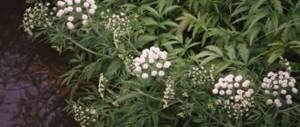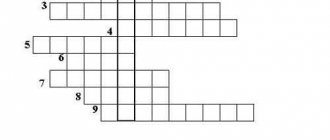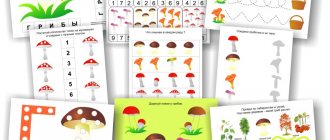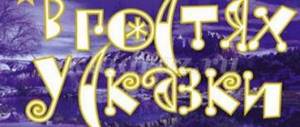MAGAZINE Preschooler.RF
Quiz "Art Connoisseurs"“The beautiful awakens the good” D.B. Kabalevsky.
Author: teacher Galanova Elena Gennadievna MADOU "Kindergarten No. 16" city of Kirishi, Leningrad region
Plan:
- An introductory speech about the relevance of artistic and aesthetic education of preschool children.
- Quiz “Art Connoisseurs” with the participation of children and parents of the group.
Target:
- clarification of parents’ ideas about the importance of artistic and aesthetic education of children
- creating a favorable, friendly environment conducive to fruitful, creative interaction between parents, children, and teachers.
Tasks:
1. Educational:
- clarify the ideas of parents and children about the types and genres of fine art (still life, portrait, landscape)
- consolidate knowledge of colors and shades
- consolidate knowledge of the names of artists and their works.
2. Developmental:
- develop aesthetic perception of objects of fine art
- develop fantasy, imagination
- consolidate the ability to select materials for making cards ( “Valentines” ).
3. Educational:
- enrich the emotional and sensory sphere of children
- cultivate a friendly attitude towards each other, the ability to complete tasks together.
Equipment and materials:
tape recorder, 2 large tables, easel, colored chips for the jury, exhibition of reproductions of paintings by artists, artistic and educational games ( “Color examples” , “Remove the extra one” , “Assemble a landscape” , “What does it look like” ), materials for decorating “Valentines” " , large printed quote from D.B. Kabalevsky “The beautiful awakens the good .
Preliminary work:
viewing reproductions of paintings by artists; drawing still lifes, landscapes, portraits; experimenting with paints; didactic games “Collect a landscape” , “What is it like” , “Find a pair” , “Paints” ; learning the song “Spring Drops” .
1. Opening remarks
Aesthetic education is the development of the ability to perceive, feel, and understand beauty in life and art, fostering the desire to participate in the transformation of the surrounding world according to the laws of beauty, familiarization with artistic activity and the development of creative abilities.
A special role in aesthetic education is given to art. Exciting and delighting, it reveals to children the social meaning of life’s phenomena, makes them look more closely at the world around them, encourages them to empathize and condemn evil.
Aesthetic education through the means of art is designated by the term “artistic education” . Conducted pedagogical and psychological studies show that as a result of upbringing, preschool children can perceive and understand works of art available to them, and penetrate into their meaning and content.
Art education in kindergarten is carried out in 2 ways:
- nurturing the ability to aesthetically perceive the phenomena of reality both directly in life itself and through works of art
- activities related to art: singing, dancing, listening to music, reading poems, telling fairy tales, dramatization games, drawing, modeling, appliqué.
The development of the ability for creative activity is impossible without expanding the scope of children’s ideas, without enriching them with artistic impressions. Children's feelings gradually become diverse and more stable. Therefore, we can set the task of developing aesthetic feelings and the ability to perceive art in preschool children.
Aesthetic perception is formed:
- in the process of observation in nature
- in the aesthetics of the surrounding reality, everyday life
- in art (word of art, music, visual arts).
2. Quiz “Art Connoisseurs”
Two teams are participating: “Magic Palette” , “Funny Pencils” .
Progress:
1st round “Warm-up”
Host: You will tell me: “There is no more magic in the world.” But under the brush the Sky, the sun and the grass come to life.
A magical wave - and the palette spilled into a sea of colors, I heard the hum of the wind, a bird rose into the sky.
Splashes, paints, a drop of blue - And the river is already flowing. The artist’s hand gives us a new world in the painting.
Presenter: The artist, when painting his paintings, uses many colors and shades.
Task No. 1 for the “Magic Palette”:
“Name the primary colors from which all the others are made”.
(Red, yellow, blue.)
Task No. 1 for “Funny Pencils” :
"Name all the colors of the rainbow".
(Red, orange, yellow, green, blue, indigo, violet.)
Task No. 2 for both teams: “Color the poem .
(Each team has a strip on the table on which they need to lay out colored squares in the order the colors are named in the poem.)
There is joy hidden in every color, A miracle pencil draws... There are so many colors on the Planet, Take a look at our drawing!
Blue sky, yellow sun, Slopes of high brown mountains, Green trees, red poppies And blue expanses of lakes.
The jury checks the correctness of the tasks and records the results on the easel with chips.
2nd round “Main genres of fine art”
Host: Both teams did a great job in the warm-up, let's move on to the main competition.
Task No. 1 “Guess the riddle”
"Magic Palette":
If you see in the picture a Cup of coffee on the table, Or fruit drink in a large decanter, Or a rose in crystal,
Or a bronze vase, Or a pear, or a cake, Then a similar picture is called... (still life)
"Funny Pencils":
If you see in the picture a river is drawn, or a spruce and white frost, or a garden and clouds
Or a snowy plain, Or a field and a hut, Then a similar picture is called... (landscape)
The presenter praises the teams and invites them to solve more riddles.
"Magic Palette":
If you see someone looking at you from a painting, Or a prince in an old cloak, Or a steeplejack in a robe,
A pilot or a ballerina, Or Kolka, your neighbor, The picture must be called... (portrait)
"Funny Pencils":
Multi-colored children are huddled in a narrow house. As soon as you release it into the wild - Where there was emptiness,
There, look - beauty! (colour pencils)
Presenter: Well done, teams! They showed their wits and guessed the riddles. Now let's see how the teams distinguish between painting genres.
Task No. 2. "Find the odd one out"
(The envelopes contain mini-reproductions of landscapes, portraits, and still lifes. For one team, the extra one is a portrait, for the other, a still life.)
The leader praises the teams
announces a competition for captains “Assemble a landscape” .
(Captains assemble a landscape from cut-out pictures. The captain who assembles the picture faster wins.)
Task No. 4. “What does it look like?” (Teams take turns calling out options.)
Rainbow (yoke, clamp, bridge, etc.);
elephant (house, vacuum cleaner, ship, etc.);
orange (ball, sun, apple, etc.);
snow (cloud, cotton wool, ice cream, etc.).
Presenter: Well done, teams! Any artist must have a developed imagination and fantasy! And now I want to ask you to name the names of the artists you know.
Task No. 5 “Name the names of the artists”
( "Magic Palette" - domestic artists, "Merry Pencils" - foreign)
The presenter announces a musical break. Children sing a song about spring “Spring Drops” .
The jury sums up the results of the 2nd round.
3rd round “Creative”
“Valentine” together with their parents .
The jury sums up the results of the quiz, and all participants are awarded memorial certificates for the quiz participants.
A child reads a poem:
And at six, and ten years old, and at five All children love to draw. And everyone will boldly draw everything that interests him:
Flowers, drawings, forests and fairy tales Everyone will draw, if only there were paints, And a sheet of paper on the table, And peace in the family and on earth!
| Next > |
Competition - quiz “Art Connoisseurs”
Art connoisseurs
(Quiz competition)
(extracurricular activity)
Goal: Developing interest in the subject of fine arts, involving parents in the artistic activities of children. Objectives: 1. To teach children to put into practice the knowledge, skills and abilities acquired in fine arts lessons, to deepen their knowledge in the subject “Fine Arts” using gaming technologies. 2. Develop the ability to quickly build logical chains, think, and reason. 3. Cultivate curiosity, a sense of humor, and the joy of communicating with beauty. Contribute to the unity of the class team, as well as children and adults. Form: Family competition - quiz Participants: students, class parents, class teacher. Preparatory stage: Parents and children receive invitations to take part in the “Art Connoisseurs” quiz competition. The class teacher prepares the holiday script, appoints those responsible for decorating the classroom, holding competitions, and preparing invitations to families. It is necessary to arrange tables for the competition participants and draw signs to identify teams. Children's songs can serve as the musical background for the holiday. Competition scenario Class teacher: Hello, dear parents and children! We have gathered with you to take a break from problems and routine work; I hope you will appreciate the jokes and humor of our tasks and competitions. Today the game involves mixed teams: adults and children. First, we need to split into two teams. To do this, I will ask you to take one card from the table. Class teacher: So, those who have “contrasting colors” on the card - I will ask you to sit at one table, those who got “close colors” - at another table. One team is called “Contrast”, and the second “Harmony”. You will be evaluated by an independent jury, our guests: teachers of other classes. Introducing our presenters: Masha and Sasha.
Sasha: - We're starting. The first "Verifier" competition
.
Listen to the task, say the word “yes” or “no” in response. (Masha and Sasha take turns reading out the tasks) • With a simple pencil of medium hardness, you can draw a line 5.5 km long.
(Yes, but whoever doesn’t believe it, let him check it) • A sketchbook is a book with notes for sketches. (No. This is a special flat box with supplies for drawing and painting). • The Laughter Room is a room in an art gallery where the work of cartoonists is displayed. (No. This is an attraction, a hall with distorting mirrors.) • Leonardo da Vinci was left-handed. (Yes) • The Hermitage houses a collection of tin soldiers collected by our artist Alexander Benois (Yes.) • Glue painting is painting in the style of the painter Paul Klee (No. This is painting in which glue serves as a binder for paints.) • The Tretyakov Gallery in Moscow is named after Vladislav Tretyak, the famous hockey goalkeeper. (No, in honor of Pavel Tretyakov, who founded the gallery in 1856) • Evgeny Charushin, author of the popular children's books “Wolf and Others”, “About Temka” - one of the most interesting animal artists in our country. (Yes. He drew the heroes of his wonderful books himself). Competition No. 2Anagrams
(painting, sculpture, architecture) The competition evaluates the speed and accuracy of completing a task.
Each team has 3 questions prepared. Words: Paint (material for drawing) Album (collection of reproductions, photographs) Ornament (painting, sculpture and graphic decoration) Arch (arched covering of an opening in the wall) Masterpiece (exemplary creation of the master) Hermitage (art museum in St. Petersburg) Competition No. 3 “Monotype”
Sasha: - Each team has an A-3 format and a jar of ink on the table. Masha: - Both teams create their own blot and exchange their creativity with the other. Sasha: — You need to complete and protect the resulting artistic image. The created image and original protection are evaluated.
- Competition No. 4 “Let’s joke together”
• What is the name of the semi-finished painting?
(Sketch) • Doctor of works of art. (Restorer) • An artist with a sense of humor. (Cartoonist) • Eared parts of buildings. (Walls. “Even walls have ears.”) • Name the lady who works as an Atlas. (caryatid) • What does the artist “drive into paint”? (brush) • Name the artist’s drawing board? (easel) Masha announces the next competition No. 5 “Colorist” -
a competition for captains.
Sasha: - Find each concept or object its own color - the one that the people have already found and inserted into sayings. Maria: The correct defense of your answer option is assessed. Yearning …. (green - terrible melancholy) Stocking..... (blue - a woman deprived of femininity) Glasses... (pink - representing everything in a pleasant color) Girl... (red - beautiful, affectionate treatment) Hands... (golden - skillful hands of a master) Competition No. 6 “Broadening our horizons”
Sasha: - Fan competition. Points are added to the team whose fan turns out to be more erudite - The white pebble melted and left marks on the board (Chalk.)
- I have a magic wand, friends. With this shelf I can build a tower, a house and an airplane, and a huge steamship! (Pencil)
- Multi-colored sisters, Bored without water. Uncle is long and thin, carries water with his beard. And the sisters, together with him, will draw a house and smoke. (Brush and paints).
- I hold a huge house in my hands, Where the drawings live And everyone knows this house It’s called... (Album).
- To remove unnecessary traces And get an A. Here he will always help us We get... (Sterka)
Competition No. 7 “Test your intelligence”
Masha: - Each team needs to answer 6 questions correctly, be careful, only the first answer counts.
1. Name three primary colors. (Red, blue, yellow)
- Which of the following colors is not a warm color - red, blue,
yellow, brown
- What material is the Dymkovo toy made from? (Made from clay).
- What colors need to be mixed together to get green? (Yellow and blue).
- Give the name of the painting, which includes flowers such as “rosan” and “kupavka”. (Gorodets painting).
- The beginning is the voice of a bird The end is at the bottom of the pond, And you can easily find the whole in the museum (Picture).
Sasha: — The last final competition “Name the author of the work.” Masha: - The jury, be careful, the final of the game is decided by this competition. The jury sums up the results. Class teacher: - There are winners, there are losers. But this is not the main thing, the main thing is that we got together, enjoyed the game, learned our gaps and I hope there was a desire to learn new, unknown things in the field of “Art”
Art quiz for 7th grade
Scenario for an art quiz game
Quiz on fine arts “Experts of fine arts” (for 7 classes of special (correctional) educational schools of the VIII type)
Author: Marina Albertovna Aksenova, fine arts teacher State budgetary educational institution of the Arkhangelsk region for students, pupils with disabilities “Solombala special (correctional) ) general education boarding school”, Arkhangelsk
Artistic and aesthetic education of children in a correctional school of the VIII type is an important direction in the implementation of educational, educational and correctional training tasks. In the process of students mastering the fine arts program, the teacher must contribute not only to the development of children’s drawing skills, but also to form children’s artistic taste, as well as introduce children to the fine arts as part of the world artistic culture. One of the most favorite among students is quizzes held between classes. Modern means of technical equipment make it possible to expand the capabilities of the teacher, make the conduct of such quizzes bright and colorful, and enhance the effects of visualization, which is undoubtedly important for such a subject as fine arts. This quiz is conducted using a multimedia presentation, and handouts are also used for students to complete practical tasks. The goal is to teach children to put into practice the knowledge, skills and abilities acquired in art lessons. Objectives: — systematization of existing knowledge; — development of creative abilities; — fostering a sense of camaraderie, mutual assistance, promoting cohesion among class teams; — correction and development of visual and auditory perception. Equipment: Paper, pencils, interactive whiteboard/multimedia installation
Progress of the event
Teacher: Hello guys!
I'm glad to see you at the visual arts quiz. I suggest you develop into 2 teams and choose a captain for each team. Students are divided into teams. Teacher: We present you with drawing questions that you will need to answer. Time will be allotted for each question; before giving an answer, discuss it in the team and give the floor to the captain. Points will be awarded for each correct answer. Task 1 : Guys, find 7 artist objects:
Correct answers: Paint, charcoal, pencil, drawing, paper, eraser, brush Task 2. A genre in which the main character is nature. a) still life b) landscape c) portrait Correct answer: Landscape comes from the French word for “terrain”, i.e. nature. A genre in which nature is the main character is called landscape. Task 3. An artist depicting people. a) animal painter b) landscape painter c) portrait painter Correct answer: A depiction of a person is called a portrait, and an artist who depicts people is called a portrait painter. Task 4. Guys, do you know what an anagram is? An anagram is a word in which all the letters are mixed up and are out of place. For example, ASKRAK is a clear word, but if you and I rearrange the letters, we get PAINT. Let's try to solve a few anagrams: SHARKANAD TURNAMORTH MOBAL SALTIC SIZHIPOVI KATNAIR ZEYUM TRPORT Correct answers: pencil, still life, album, eraser, painting, picture, museum, portrait. Task 5. You have all seen how a rainbow appears in the sky after rain. There are seven colors in the rainbow and they all come in order, one after another. Name the colors of the rainbow in order. (In case of difficulty, children can be shown an illustration of a hunter and a pheasant). Correct answer: red, orange, yellow, green, blue, indigo, violet. Task 6. Mixing which two colors produces orange? a) yellow and blue b) red and blue c) red and yellow Correct answer: Orange is obtained by mixing red and yellow. Task 7. Name the Russian scientist, our fellow countryman, who revived the art of mosaic. a) I.E. Repin b) M.V. Lomonosov c) I.I. Shishkin Correct answer: The art of mosaic was revived by our great fellow countryman, the brilliant scientist Mikhail Vasilyevich Lomonosov. Task 8. Name the genre in which Ivan Ivanovich Shishkin’s painting “Rye” was painted.
Correct answer: Ivan Ivanovich Shishkin is a great Russian landscape painter. The main theme in his works was nature. The painting “Rye” was painted in the genre of landscape. Task 9. Name the genre in which Valentin Aleksandrovich Serov’s painting “Girl with Peaches” was painted.
Correct answer: Serov's painting depicts Vera Mamontova. A genre of fine art that depicts people is called a portrait. Task 10. Here is a painting by Kuzma Sergeevich Petrov-Vodkin “Apple and Grapes”. Name the genre.
Correct answer: A painting that depicts inanimate objects: fruits, vegetables, other food, household items is called a still life. The painting “Apple and Grapes” is a still life. Task 11. Guys, drawing, like any other art, is impossible without imagination. There are unfinished drawings in front of you, please complete them.
Calculation of team points, determination and awarding of winners. Teacher: Dear guys, well, our quiz has come to an end. You know a lot of interesting things about fine arts. Thank you very much for this! I hope to see you again in the future! Goodbye!
We recommend watching:
Tournament "Funny Colors" for children in grades 5-7. Scenario Summary of an art lesson for grades 7-8. Design of the architectural environment Extracurricular lesson in fine arts in 2nd grade Synopsis of an extracurricular activity in fine arts in elementary school
Similar articles:
Quiz on fine arts “In the world of beauty” in 7th grade
Quiz with answers for grades 6-7. Pushkin
History quiz with answers, grades 6-7
History quiz with answers for schoolchildren, grades 7-8
Medical quiz for schoolchildren with answers








